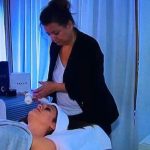I’ve never considered myself to have sensitive skin. In fact, I always felt like it was basically a shield of armor, which is rather ideal for a beauty editor consistently using her own face and body as a guinea pig for products and lotions and potions and weird treatments. No odd reactions, no problem.
But then one day, seemingly all of a sudden, my skin started freaking out. Redness, stinging, burning, blotchiness. My pores looked bigger? Moisturizers I loved in the past we’re making my face feel like it was on fire, and anything with fragrance was a BIG no-no.
I immediately pared down my routine because if I didn’t, I’d be walking around all day, every day looking like I just finished a 10 mile run. I had my suspicions, and after chatting with a facialist, it was her conclusion that this newly sensitive skin was of my own personal doing through over-exfoliation.
RELATED: The Best Anti-Aging Serums
“My work consists of reading the skin and analyzing different concerns that are showing on the surface,” says facialist Ildi Pekar when I asked her about my skin. “While I was reading your skin, it was showing me signs that you were over-exfoliating. The side effects/symptoms of that is skin sensitivity, redness, blotchiness, and irritation.”
So how does over-exfoliation happen exactly? According to Dr. Melanie Palm, a board-certified dermatologist, cosmetic surgeon, and Medical Director of Art of Skin MD, it can be caused by a few different situations, including over-aggressive use of a hand-held cleansing device, having an issue with the ingredient in the product, or using a topical exfoliant with physical particles (i.e. a scrub).
“Some of the most frequently used exfoliating masks employ particulates or beads to cleanse the skin,” says Dr. Palm. “While on oily or combination skin this may be OK, on rosacea-prone or sensitive skin types this may be disastrous. The physical beads over time could actually cause new broken blood vessels in rosacea skin types, and these particulates are too harsh on delicate skin areas or sensitive skin types.”
And getting too liberal with your peel pads is no better either, as dermatologist Dr. Marina I. Peredo says this can also happen after contact with high concentrations of chemical exfoliants.
Mild or moderate over-exfoliation might result in pink or redness, dryness, or rough skin texture (what I was dealing with), but Dr. Palm says in the most severe cases, people can experience rashes, scabbing, bleeding, itching, stinging, and possibly scarring and hyper-pigmentation.
Fixing this sitch, though, is relatively manageable. First, you’ll want to lay off the scrubbing and switch to a topical product that is simple, moisturizing, and anti-inflammatory. Dr. Palm suggests a 1% hydrocortisone cream or products with colloidal oatmeal to calm. She also says that you can use green tea or tea tree oil for spots of irritation.
You might already have a few skin saviors in your arsenal. Dr. Peredo says you can apply good ole Aquaphor ($5; target.com) for a few nights in a row and then apply Dickinson’s Enhanced Witch Hazel Alcohol Free Hydrating Toner ($6; walmart.com) in the AM to hydrate your skin.
As for cleansers, skip out on the anti-aging or acne-based products for a while, and pick up something with hyaluronic acid or ceramides as the call-out ingredient.






